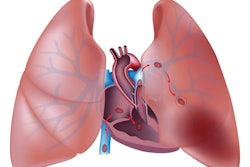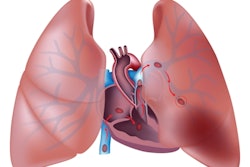The growing use of CT pulmonary angiography (CTPA) is behind a rising tide of pulmonary embolism (PE) diagnoses, claims a study published May 9 in the Archives of Internal Medicine. As evidence, the authors note that the growth in scanning has not significantly reduced deaths from the disease, leading them to question the wisdom of treating small emboli.
Meanwhile, complications from anticoagulant treatment for PE are soaring, underscoring the reality that prophylactic treatment with anticoagulants -- most often warfarin -- is "not benign," said the research group.
"Rather than an epidemic of disease, we think the increased incidence of PE reflects an epidemic of diagnostic testing that has created overdiagnosis," wrote Dr. Renda Soylemez Wiener, from Boston University School of Medicine, and colleagues from the Department of Veterans Affairs in White River Junction, VT, and Dartmouth Medical School.
"In this scenario, much of the increased incidence in PE consists of cases that are clinically unimportant, cases that would not have been fatal even if left undiagnosed and untreated," they wrote (Arch Intern Med, May 9, 2011, Vol. 171:9, pp. 831-837).
CTPA hits the ground running
The 1998 introduction of CT pulmonary angiography "revolutionized" how doctors approached PE, Wiener and her team wrote. "Many assumed this highly sensitive test would improve outcomes of this deadly disease by detecting and allowing treatment of emboli that were previously missed."
As CTPA became the test of choice, with usage rising 11-fold by 2006, other PE tests such as ventilation/perfusion scans and invasive angiography fell out of use. CTPA is now recommended as a first-line test by both professional societies and practicing physicians, and in 2007, 2.6 million CTPA scans were performed in the U.S.
"If increasing use of CTPA was improving our ability to find and successfully treat clinically important pulmonary emboli, we would expect to see an increase in incidence (since highly sensitive CTPA finds pulmonary emboli that were previously missed) and a reduction in mortality (because of successful treatment of the 'new' pulmonary emboli)," the authors wrote. "On the other hand, if CTPA primarily improves our ability to find pulmonary emboli of minimal clinical significance, we would expect to see rising incidence, but little change in mortality."
Analyzing PE before and after CTPA
To assess the impact of CTPA on PE incidence, mortality, and treatment complications in the U.S., the authors conducted a time trend analysis to determine estimates of hospitalization for PE using the Nationwide Inpatient Sample (NIS), a database that includes all discharges from a 20% stratified sample of nonfederal hospitals in the U.S. The NIS was also used to determine case fatality, defined as the proportion of hospital deaths among patients with PE.
PE mortality was determined using Multiple Cause-of-Death Mortality Data from the National Vital Statistics System of the U.S. National Center for Health Statistics. This source contains data from all U.S. death certificates, listing up to 20 contributing causes of death as ICD-9 codes.
From 1993, five years before CTPA was introduced, until 2006, the authors calculated the annual number of hospital discharges with a diagnosis of PE per 100,000 U.S. adults to measure incidence. PE mortality was defined as the annual number of deaths per 100,000 U.S. adults in which PE was listed as a contributing cause.
The results showed that PE incidence was unchanged in the five years before the introduction of CTPA in 1998 (p = 0.64) but increased substantially in the five years after CTPA debuted (81% increase, from 62.1 to 112.3 per 100,000 population [p < 0.001]).
PE mortality dropped 8% in the five years before the introduction of CTPA, from 13.4 to 12.3 per 100,000 (p < 0.001). But mortality fell by only 3% in the five years following its introduction, from 12.3 to 11.9 per 100,000 population (p = 0.02).
Case fatality dropped slightly by 8%, from 13.2% to 12.1% (p = 0.02), before CTPA's debut, but dropped far more substantially by 36%, from 12.1% to 7.8% (p < 0.001), in the five years following CTPA's introduction.
The authors found the same pattern among patients with PE as a primary diagnosis. Complication rates were stable before the introduction of CTPA, at 1.2 to 1.5 per 100,000 population (p = 0.07), but increased during the five years after CTPA was introduced, when complications rose by 47% from 1.5 to 2.2 per 100,000 (annual percentage change, 5.2%; p < 0.001).
"After CTPA was introduced, case fatality decreased by a third for all patients with PE and by half for patients with a primary diagnosis of PE, while falling only 20% among all medical admissions," Wiener and colleagues noted.
As for why, the authors indicated that the epidemiologic patterns of PE have changed since CTPA was introduced. Compared with the pre-CTPA era, PE incidence rose, mortality changed little, and case fatality decreased.
Diagnosing insignificant disease?
CTPA is the only possible culprit in the rising incidence for a couple of reasons, according to the group. First, the rapid increase in PE incidence occurred only among nonfatal emboli, and second, a true increase in PE incidence requires a corresponding increase in risk factors.
"PE may actually be decreasing: In the past several years, quality improvement efforts have focused on increasing prophylaxis against venous thromboembolism in hospitalized patients," the authors wrote.
Yet PE incidence continued to rise, tripling in obstetric patients after CTPA was introduced.
"Overdiagnosis explains the increased incidence, decreased case fatality, and minimal change in mortality we observed," they wrote. "If the extra emboli diagnosed were clinically important and benefited from treatment, mortality (i.e., number of fatal pulmonary emboli/population at risk) would show a parallel decrease."
Case fatality decreases "because the denominator has been inflated with clinically insignificant cases that are only identifiable by highly sensitive tests," such as CTPA, they wrote.
Overdiagnosis can occur whenever a large reservoir of undiagnosed cases runs into a new, sensitive test to detect them, the group wrote. Both of these conditions are true for PE, though CTPA can often distinguish new from old lesions.
"Signs of recent or prior PE can be identified in more than half of autopsies if the pulmonary arteries are meticulously examined," they noted. "Moreover, among consecutive patients undergoing contrast chest CT for unrelated reasons (e.g., cancer staging), unsuspected emboli are found in 4% overall, in 17% of patients older than 80 years, and in 24% of asymptomatic trauma patients."
"Unfortunately, it is not possible to ascertain definitively from radiographic appearance alone how the patient will fare clinically," Wiener wrote in an e-mail to AuntMinnie.com.
Noting several study limitations, Wiener and colleagues wrote that the practice of "upcoding" to a PE diagnosis to maximize reimbursement may account for some, though very unlikely all, of the increase in incidence.
In addition, the NIS database doesn't track individual patients, so patients who are discharged and then readmitted may be erroneously counted as two unique individuals with PE, they wrote.
Third, death certificates undercount mortality, with a demonstrated sensitivity of only 40% for getting a PE diagnosis right compared to autopsy results. Finally, some emboli may represent false-positive results.
Overdiagnosis matters because PE treatment can cause real harm, according to the authors.
The use of new anticoagulation drugs such as dabigatran may ultimately prove safer than warfarin, but "any type of anticoagulation confers a risk of bleeding," Wiener wrote in her e-mail. "If there are emboli that truly do not benefit from treatment, exposing patients to any anticoagulation agent is exposing them to unnecessary risk."
There were significant increases in complications in the hospital and even more in long-term use: 12% of patients on anticoagulation therapy for three to six months experience clinically significant bleeding, the authors wrote.
A recent study found that patients with subsegmental emboli detected by MDCT are far more likely to experience complications from anticoagulation than from the embolism itself, they added.
"Because the harms of treatment can be substantial, including in the worst case death, it is imperative that we do not turn the problem of underdiagnosis into one of overdiagnosis," Wiener and colleagues concluded. "It is time to strengthen the evidence base: A trial randomizing stable patients with small emboli to observation versus anticoagulation would help determine whether all patients with PE require treatment."
"I think a randomized trial of stable patients is feasible and, in fact, warranted," Wiener told AuntMinnie.com. "Doctors often err on the side of treatment in situations of uncertainty. However, in the case of small subsegmental pulmonary emboli in a hemodynamically stable patient, treating with anticoagulation may be doing more harm than good."




















